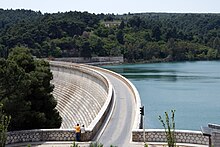Marathon Dam
| Marathon Dam | |
|---|---|

The dam and reservoir
|
|
|
Location of Marathon Dam in Greece
|
|
| Country | Greece |
| Location | Marathon |
| Coordinates | 38°10′01″N 23°54′19″E / 38.16694°N 23.90528°ECoordinates: 38°10′01″N 23°54′19″E / 38.16694°N 23.90528°E |
| Status | In use |
| Construction began | 1926 |
| Opening date | 1929 |
| Owner(s) | EYDAP |
| Dam and spillways | |
| Type of dam | Gravity |
| Impounds | Charadros River |
| Height | 54 m (177 ft) |
| Length | 285 m (935 ft) |
| Width (crest) | 4.5 m (15 ft) |
| Width (base) | 28 m (92 ft) |
| Spillway type | Service, uncontrolled chute |
| Spillway capacity | 520 m3/s (18,364 cu ft/s) |
| Reservoir | |
| Creates | Lake Marathon |
| Total capacity | 41,000,000 m3 (33,239 acre·ft) |
| Active capacity | 34,000,000 m3 (27,564 acre·ft) |
| Inactive capacity | 7,000,000 m3 (5,675 acre·ft) |
| Catchment area | 118 km2 (46 sq mi) |
| Surface area | 2.45 km2 (1 sq mi) |
| Max. water depth | 54 m (177 ft) |
The Marathon Dam is a gravity dam on the Charadros River, near its junction with the Varnavas Stream, 8 km (5 mi) west of Marathon and 45 km (28 mi) northeast of Athens in Greece. The dam created Lake Marathon for the primary purpose of municipal water supply. Constructed between 1926 and 1929, it was the sole supplier of water to Athens until 1959. The dam is often cited for its role in the modernization of Greece and the first recorded case of seismic activity associated with reservoir inundation. It was also designed to be symbolic of Ancient Greece, particularly Athenians and the Battle of Marathon.
The Marathon Dam was originally proposed, designed, funded and tendered in 1918, but was declared illegal by Prime Minister Dimitrios Gounaris, who succeeded Eleftherios Venizelos in late 1920, because there had been no public bidding for the project. With a strong influx of Greek refugees from Asia Minor following the defeat at the Greco-Turkish War of 1919–1922 (the "Asia Minor Disaster") and the 1923 Treaty of Lausanne, which led to the population exchange between Greece and Turkey, Greek officials were searching for a means to supply Athens with more water. An estimated 1.3 million refugees were returning and the population of Athens would end up doubling between 1920 and 1928. At the time, Greece underwent a period of political turmoil that saw the fall of the monarchy and the establishment of a Second Hellenic Republic, as well as several military coups and counter-coups. Near the end of this period, all major water supply projects for Athens were reevaluated and a five-volume report was published. The report described the Marathon Dam as "the optimal solution" and the "last recourse" for Athens.
...
Wikipedia

